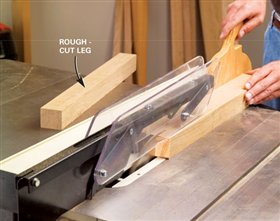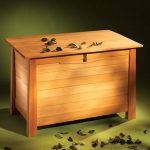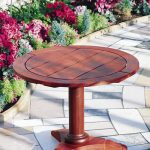We may receive a commission when you use our affiliate links. However, this does not impact our recommendations.
Tile-Topped Outdoor Table
This sturdy white-oak table will last a lifetime and won’t blow over in the wind.
by Jock and Susan Holmen
| If you love lounging on your deck and need a solid side table to hold your cool drink and snacks, here’s the solution. We designed this stylish side table to be simple to build. It’s made of white oak and finished with an outdoor stain, so it’s sure to handle the weather. The ceramic-tile top provides a durable maintenance-free accent. |
You may also like…
|
Project Requirements at a GlanceTools: Tablesaw, bandsaw, plate joiner, Materials: 4 bd. ft. of 8/4 (2″) white oak, 8 bd. ft. of 5/4 (1-1/4″) white oak, No. 20 biscuits, one 12″ x 12″ ceramic tile, exterior wood glue, exterior stain, silicone caulk. Total cost : About $75. Before you StartBuy your ceramic tile before you build this table, because the actual size of tiles can vary. We purchased a single 12″ square x 1/4″ thick ceramic tile at our local home center. The actual size was closer to 11-7/8″ square. The tile is undersize to allow a grout joint in normal applications, but the amount can vary. We used white oak for its natural resistance to rot (see Sources, below). Other wood, such as mahogany, teak, cedar or ipe, will also withstand the elements. Taper the LegsStart by sawing the 8/4 lumber for the legs (A) 1/8″ oversize (Photo 1). Then joint, plane and cut to the final size (see Cutting List, below). Next, mark an X at the top of two adjacent sides on each leg. These two marked sides will be tapered. Use these Xs to help you keep track of the tapers. The tapers are subtle and it’s possible to confuse them with the untapered outer sides (see Oops! below). Also, the legs are untapered where they join the aprons (B, Fig. A, below). Mark lines for the tapers on each leg and saw the taper on the bandsaw (Photo 2). Stay about 1/16″ away from your pencil line. After the first taper is cut, reattach scrap with masking tape and cut the second taper. Remove the bandsaw marks with a pass or two over your jointer (Photo 3). Cutting the Double Biscuit SlotsUsing spacers makes easy and accurate work out of cutting the double biscuit slots in the legs. This setup works with any biscuit joiner and the only measuring you need to do is to locate the center of the slot down from the top of the legs (Fig. A). Make sure to cut the biscuit slots in the legs with the adjacent taper down (Photos 4 and 5). Make the ApronsCut the aprons (B) to final size. Cut the decorative groove on the bottom outside face (Fig. A) on your tablesaw using a standard 1/8″ kerf saw blade. The groove is also a handy way to keep track of the outside face of the aprons during the upcoming biscuit-cutting steps. With the decorative groove facing down, cut the double biscuit slots in the ends of the aprons. Cut the first slot without any spacer and the second one with a 3/8″ spacer (Photos 6 and 7). Assemble the BaseFirst make two leg assemblies by gluing two legs and one apron together, then the other two legs and an apron (Photo 8). Make sure the decorative groove on the apron is facing out. Use an exterior glue for this project (see Sources, below). After the glue has dried, complete the table base by adding the other two aprons (Photo 9). Add the TabletopWith your chosen tile in hand, use the information in the Cutting List’s notes, below, to determine the correct lengths Cut the double biscuit slots in the outer frame boards (C and D) with their top sides facing up during slot cutting. Cut Next, glue and clamp the top (Photo 10). After the base and top sections have thoroughly dried, give these assemblies a final sanding. Attach them to each other using glue blocks (F). Apply glue to each block and rub it back and forth several times until you feel the glue take hold slightly (Photo 11). Then put pressure on the block for about five seconds before letting go. Leave the table upside down until the glue is dry. Use an Exterior StainWe chose to apply exterior stain on our table. Exterior stain is very easy to apply with a brush or a rag (Photo 12). Be sure When the stain is completely dry, glue the ceramic tile in place using silicone caulk (Photo 13). Center the tile so there is a 1/16″ space between it and the wood frame. This space provides a place for rainwater to drain away. Now you’re all Oops!We were making such great progress, but we lost track of which side of this leg was tapered and cut a biscuit slot on the wrong side. Rather than make a whole new leg, we decided to repair the mistake. If you make a similar mistake, here’s how to fix it. Find a piece of wood that matches the color and grain of the leg you’re repairing. Plane the piece of wood to fit the biscuit slot. Trace half the outline of a biscuit, making your outline about 1/16 in. larger than the biscuit’s outline. Cut out this “half-biscuit” on your bandsaw or scrollsaw and test its fit. The half-biscuit should fill the slot from end to end and stand a little proud of the leg’s surface. Glue the half-biscuit into the slot. When the glue is dry, sand the half-biscuit flush with the leg. If you do a good job of matching grain, the repair should be hardly noticeable—and it sure beats making a whole new leg. Sources(Note: This information may have changed since the story’s original publication date.) Groff & Groff Lumber Inc., groffslumber.com, 800-342-0001, 8/4 white oak, $8 per bd. ft.; 5/4 white oak, $5 Woodworker’s Supply, woodworker.com, 800-645-9292, Titebond II Glue, 16 Cabot’s Stain, cabotstain.com, 800-877-
Cutting List
Fig. A: Exploded View
This story originally appeared in American Woodworker October 2004, issue #110. |
Click any image to view a larger version.
1. Rip thick lumber for the legs to rough size on the tablesaw. Always use a pushstick when cutting narrow boards. Joint, plane and crosscut the legs to final size. 2. Bandsaw two tapers on adjacent sides of each leg. Saw each taper about 1/16″ oversize. The tapers are subtle, so mark an X at the top of each one to help you keep track of which surface is 3. Smooth the tapered sides with your jointer. A freehand bandsaw cut can be fairly uneven, so smoothing might take two passes. Feed the legs top-end first. Use a push block and stick to guide the leg. 4. Cut a pair of biscuit slots in the legs. Add a 3/8″ spacer on top of the 1/4″ spacer. Spacers are far easier to use than fiddling with the biscuit joiner’s fence when you’re making these double slots. 5. Cut the second biscuit slot in the legs. Add a 3/8-in. spacer on top of the 1/4-in. spacer. Spacers are far easier to use than fiddling with the biscuit joiner’s fence when you’re making these double slots. 6. Cut biscuit slots in the aprons’ ends. Clamp the apron faceside down. That’s the side that has a decorative groove cut into it. This time, cut the first slot without the 1/4″ spacer. 7. Cut a second biscuit slot with the 3/8″ spacer under the plate joiner. This is a foolproof system for making the slots in the legs and aprons exactly the same distance apart. 8. Assemble the table base in stages. Glue together two legs and one apron using exterior glue. Make sure both legs lie flat on your bench. Repeat this step with the other pair of legs and apron. 9. Assemble the entire table base. Work on a level surface, such as the top of your tablesaw. This will ensure the finished table won’t wobble. Working upside down also prevents excess glue from dribbling down the legs. 10. Assemble the top. A small paintbrush works great for applying glue to the biscuits and slots. The tile top of this table rests on support boards that are thinner than the rest of the frame. The tile top’s support boards are connected with only a single biscuit.
11. Fasten the base to the top with glue blocks. This table doesn’t use any metal screws or brackets that can rust out. You don’t have to clamp these blocks. Just rub them hard back and forth to squeeze out the glue, and then hold them in place for a few seconds until the glue gets tacky. 12. Finish the table with an exterior stain. Let it dry thoroughly before you install the tile top.
13. Install the tile top using four spots of silicone caulk. Make sure the stain is completely dry before you install the tile, or the caulk may not stick to the support boards. |
Here are some supplies and tools we find essential in our everyday work around the shop. We may receive a commission from sales referred by our links; however, we have carefully selected these products for their usefulness and quality.


























